Local Track Irregularity Identification Based on Multi-Sensor Time–Frequency Features of High-Speed Railway Bridge Accelerations
Abstract
1. Introduction
2. Theoretical Background
2.1. Excitation of Local Track Irregularity in TTBI System Vibration
2.2. Time–Frequency Features Extraction
2.3. Local Track Irregularity Identification Based on Multi-Sensor Time–Frequency Features
3. Numerical Simulation
3.1. The Finite Element Model of High-Speed Railway Bridge
3.2. Local Track Irregularity Simulation
4. Discussion of Research Results
4.1. Multi-Domain Characteristics of Bridge Acceleration
4.2. Data Generation and Feature Extraction
4.3. Local Track Irregularity Detection
4.4. Implementation Cases for Local Track Irregularity Localization
5. Conclusions
- The action of the local harmonic irregularity on the bridge structure can be equated to the action of the moving simple harmonic load. Local harmonic irregularities in the track structure will result in additional mid- and high-frequency components in the bridge acceleration response. Moreover, these additional frequency components are related to the train speed and the wavelength of the local harmonic irregularities.
- The sum of the wavelet coefficients in the full scale was used as the local track irregularity detection index-1, which reflects the change of the time–frequency energy of the bridge acceleration with the train running position. When the train passes through the location of local irregularity, the index will have a sudden change in the spatial domain. Moreover, the degree of mutation is related to the distance from the measuring point to local irregularity. When the measurement point is closer to the local irregularity position, the peak of index-1 mutation is greater and vice versa.
- The local peak points of index-1 are used as index-2 to locate local irregularity. As many carriages pass through local irregularity, the identified local peak points have relatively obvious periodic intervals in the spatial domain, which is related to the position of the wheels in the spatial domain.The two indexes proposed in this paper have relatively strong robustness to train speed and local irregularity position, and index-2 can identify multi-point local irregularity positions.
Author Contributions
Funding
Conflicts of Interest
References
- Cantero, D.; Basu, B. Railway infrastructure damage detection using wavelet transformed acceleration response of traversing vehicle. Struct. Control Health Monit. 2015, 22, 62–70. [Google Scholar] [CrossRef]
- Garg, V.K.; Dukkipati, R.V. Chapter 3-Description of the Railway Vehicle Models and Track Geometry. In Dynamics of Railway Vehicle Systems; Garg, V.K., Dukkipati, R.V., Eds.; Academic Press: Cambridge, MA, USA, 1984; pp. 58–102. [Google Scholar]
- Bocciolone, M.; Caprioli, A.; Cigada, A.; Collina, A. A measurement system for quick rail inspection and effective track maintenance strategy. Mech. Syst. Signal Process. 2007, 21, 1242–1254. [Google Scholar] [CrossRef]
- Moritaka, H.; Matsumoto, T. Track measurement by Kyushu Shinkansen cars in commercial service. In Proceedings of the Computers in Railways XII: Computer System Design and Operation in Railways and other Transit Systems; WIT Press: Ashurst, UK, 2010; p. 147. [Google Scholar]
- Insa, R.; Inarejos, J.; Salvador, P.; Baeza, L. On the filtering effects of the chord offset method for monitoring track geometry. Proc. Inst. Mech. Eng. Part F J. Rail Rapid Transit 2012, 226, 650–654. [Google Scholar] [CrossRef]
- Kouroussis, G.; Connolly, D.P.; Alexandrou, G.; Vogiatzis, K. The effect of railway local irregularities on ground vibration. Transp. Res. Part D Transp. Environ. 2015, 39, 17–30. [Google Scholar] [CrossRef]
- Caprioli, A.; Cigada, A.; Raveglia, D. Rail inspection in track maintenance: A benchmark between the wavelet approach and the more conventional Fourier analysis. Mech. Syst. Signal Process. 2007, 21, 631–652. [Google Scholar] [CrossRef]
- Ning, J.; Lin, J.; Zhang, B. Time–frequency processing of track irregularities in high-speed train. Mech. Syst. Signal Process. 2016, 66, 339–348. [Google Scholar] [CrossRef]
- Karis, T.; Berg, M.; Stichel, S.; Li, M.; Thomas, D.; Dirks, B. Correlation of track irregularities and vehicle responses based on measured data. Veh. Syst. Dyn. 2018, 56, 967–981. [Google Scholar] [CrossRef]
- Lee, J.S.; Choi, S.; Kim, S.S.; Park, C.; Kim, Y.G. A Mixed Filtering Approach for Track Condition Monitoring Using Accelerometers on the Axle Box and Bogie. IEEE Trans. Instrum. Meas. 2012, 61, 749–758. [Google Scholar] [CrossRef]
- An, B.Y.; Wang, P.; Xu, J.M.; Chen, R.; Cui, D.B. Observation and Simulation of Axle Box Acceleration in the Presence of Rail Weld in High-Speed Railway. Appl. Sci. 2017, 7, 1259. [Google Scholar] [CrossRef]
- Karis, T.; Berg, M.; Stichel, S. Analysing the correlation between vehicle responses and track irregularities using dynamic simulations and measurements. Proc. Inst. Mech. Eng. Part F J. Rail Rapid Transit 2020, 234, 170–182. [Google Scholar] [CrossRef]
- Molodova, M.; Li, Z.; Núñez, A.; Dollevoet, R. Validation of a finite element model for axle box acceleration at squats in the high frequency range. Comput. Struct. 2014, 141, 84–93. [Google Scholar] [CrossRef]
- Li, Z.; Molodova, M.; Zhao, X.; Dollevoet, R. Squat Treatment by Way of Minimum Action Based on Early Detection to Reduce Life Cycle Costs. Mech. Syst. Signal Process. 2010, 1, 305–311. [Google Scholar] [CrossRef]
- Molodova, M.; Li, Z.L.; Dollevoet, R. Axle box acceleration: Measurement and simulation for detection of short track defects. WEAR 2011, 271, 349–356. [Google Scholar] [CrossRef]
- Yuan, Z.; Zhu, S.; Chang, C.; Yuan, X.; Zhang, Q.; Zhai, W. An unsupervised method based on convolutional variational auto-encoder and anomaly detection algorithms for light rail squat localization. Constr. Build. Mater. 2021, 313, 125563. [Google Scholar] [CrossRef]
- Zhang, Y.; Xie, X.; Li, H.; Zhou, B. An Unsupervised Tunnel Damage Identification Method Based on Convolutional Variational Auto-Encoder and Wavelet Packet Analysis. Sensors 2022, 22, 2412. [Google Scholar] [CrossRef]
- Li, H.; Lan, C.M.; Ju, Y.; Li, D.S. Experimental and Numerical Study of the Fatigue Properties of Corroded Parallel Wire Cables. J. Bridge Eng. 2012, 17, 211–220. [Google Scholar] [CrossRef]
- Li, S.; Zhu, S.; Xu, Y.-L.; Chen, Z.-W.; Li, H. Long-term condition assessment of suspenders under traffic loads based on structural monitoring system: Application to the Tsing Ma Bridge. Struct. Control Health Monit. 2012, 19, 82–101. [Google Scholar] [CrossRef]
- Li, H.; Mao, C.-X.; Ou, J.-P. Experimental and theoretical study on two types of shape memory alloy devices. Earthq. Eng. Struct. Dyn. 2008, 37, 407–426. [Google Scholar] [CrossRef]
- Bao, Y.; Shi, Z.; Beck, J.L.; Li, H.; Hou, T.Y. Identification of time-varying cable tension forces based on adaptive sparse time-frequency analysis of cable vibrations. Struct. Control Health Monit. 2017, 24, e1889. [Google Scholar] [CrossRef]
- Huang, Y.; Beck, J.L.; Li, H. Bayesian system identification based on hierarchical sparse Bayesian learning and Gibbs sampling with application to structural damage assessment. Comput. Methods Appl. Mech. Eng. 2017, 318, 382–411. [Google Scholar] [CrossRef]
- Li, S.; Wei, S.; Bao, Y.; Li, H. Condition assessment of cables by pattern recognition of vehicle-induced cable tension ratio. Eng. Struct. 2018, 155, 1–15. [Google Scholar] [CrossRef]
- Zhai, W.M.; Han, Z.L.; Chen, Z.W.; Ling, L.; Zhu, S.Y. Train-track-bridge dynamic interaction: A state-of-the-art review. Veh. Syst. Dyn. 2019, 57, 984–1027. [Google Scholar] [CrossRef]
- Zhu, Z.H.; Gong, W.; Wang, L.D.; Bai, Y.; Yu, Z.W.; Zhang, L. Efficient assessment of 3D train-track-bridge interaction combining multi-time-step method and moving track technique. Eng. Struct. 2019, 183, 290–302. [Google Scholar] [CrossRef]
- Yu, Z.W.; Mao, J.F. Probability analysis of train-track-bridge interactions using a random wheel/rail contact model. Eng. Struct. 2017, 144, 120–138. [Google Scholar] [CrossRef]
- Xu, L.; Zhai, W.M.; Li, Z.L. A coupled model for train-track-bridge stochastic analysis with consideration of spatial variation and temporal evolution. Appl. Math. Model. 2018, 63, 709–731. [Google Scholar] [CrossRef]
- Clough, R.W.; Penzien, J.; Griffin, D.S. Dynamics of Structures; McGraw Hill Inc.: New York, NY, USA, 1975. [Google Scholar]
- Råde, L.; Westergren, B. Mathematics Handbook for Science and Engineering; Springer: Berlin/Heidelberg, Germany, 2010. [Google Scholar]
- Wang, X.; Li, Z.; Zhuo, Y.; Di, H.; Wei, J.; Li, Y.; Li, S. Indirect displacement monitoring of high-speed railway box girders consider bending and torsion coupling effects. Smart Struct. Syst. 2021, 28, 827–838. [Google Scholar]
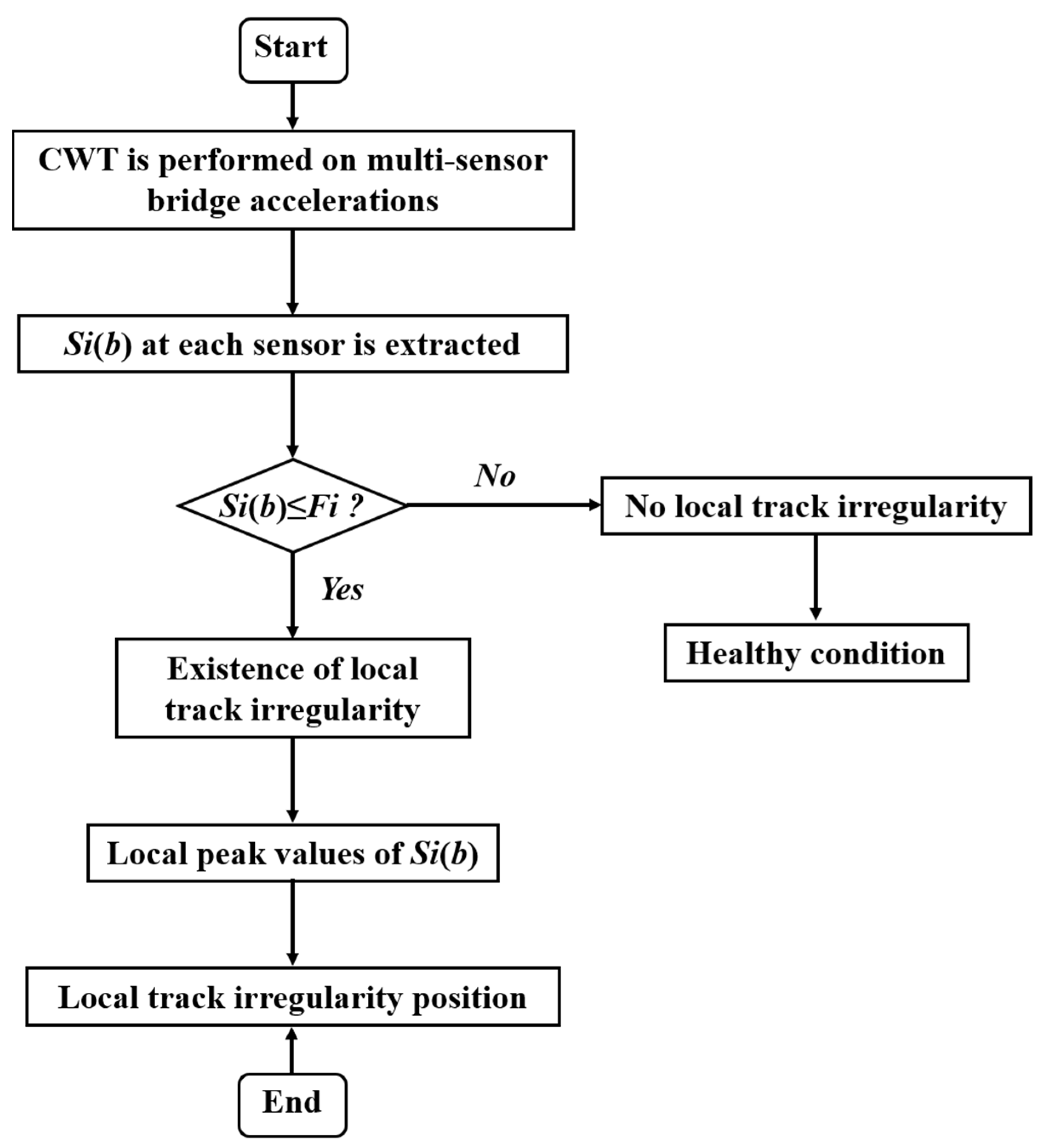

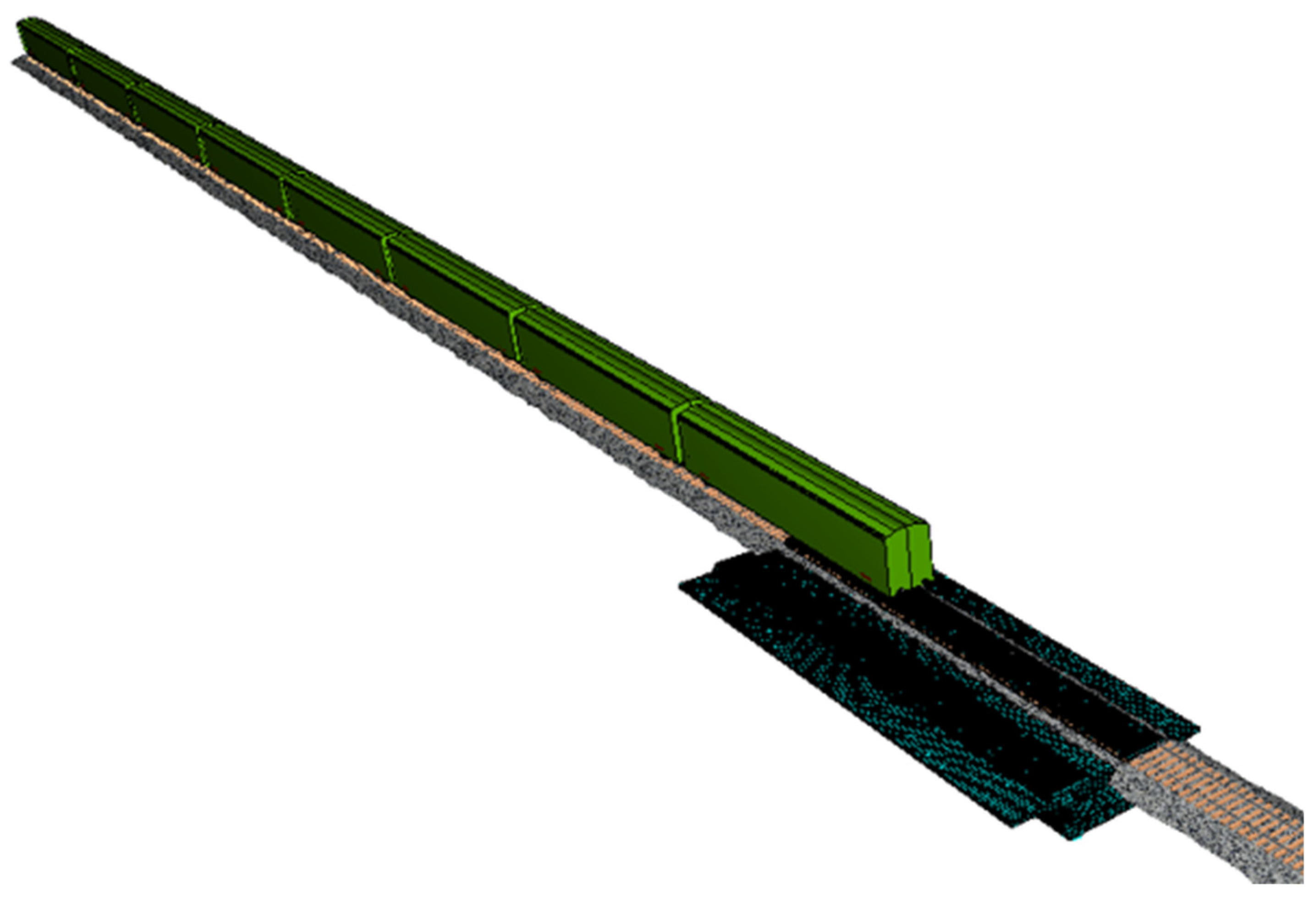
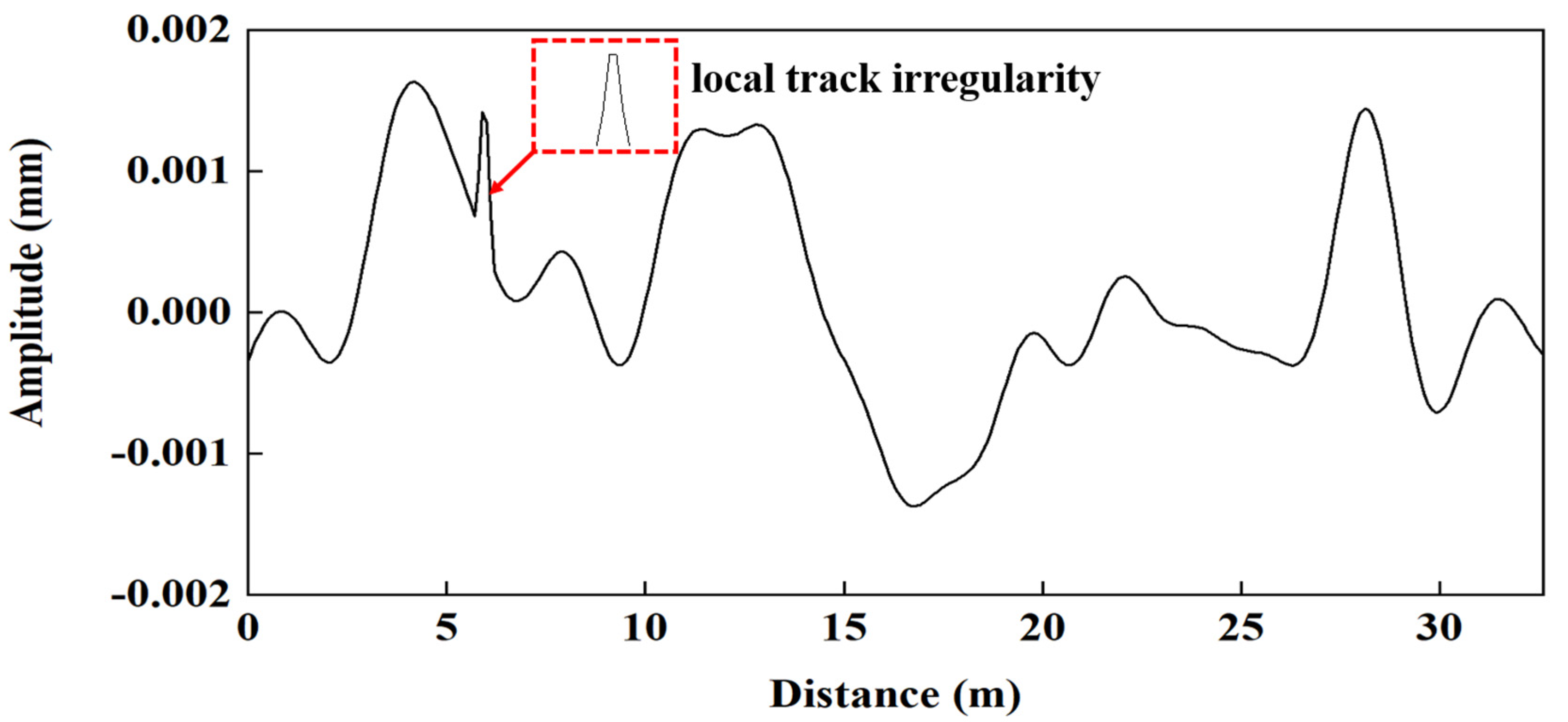
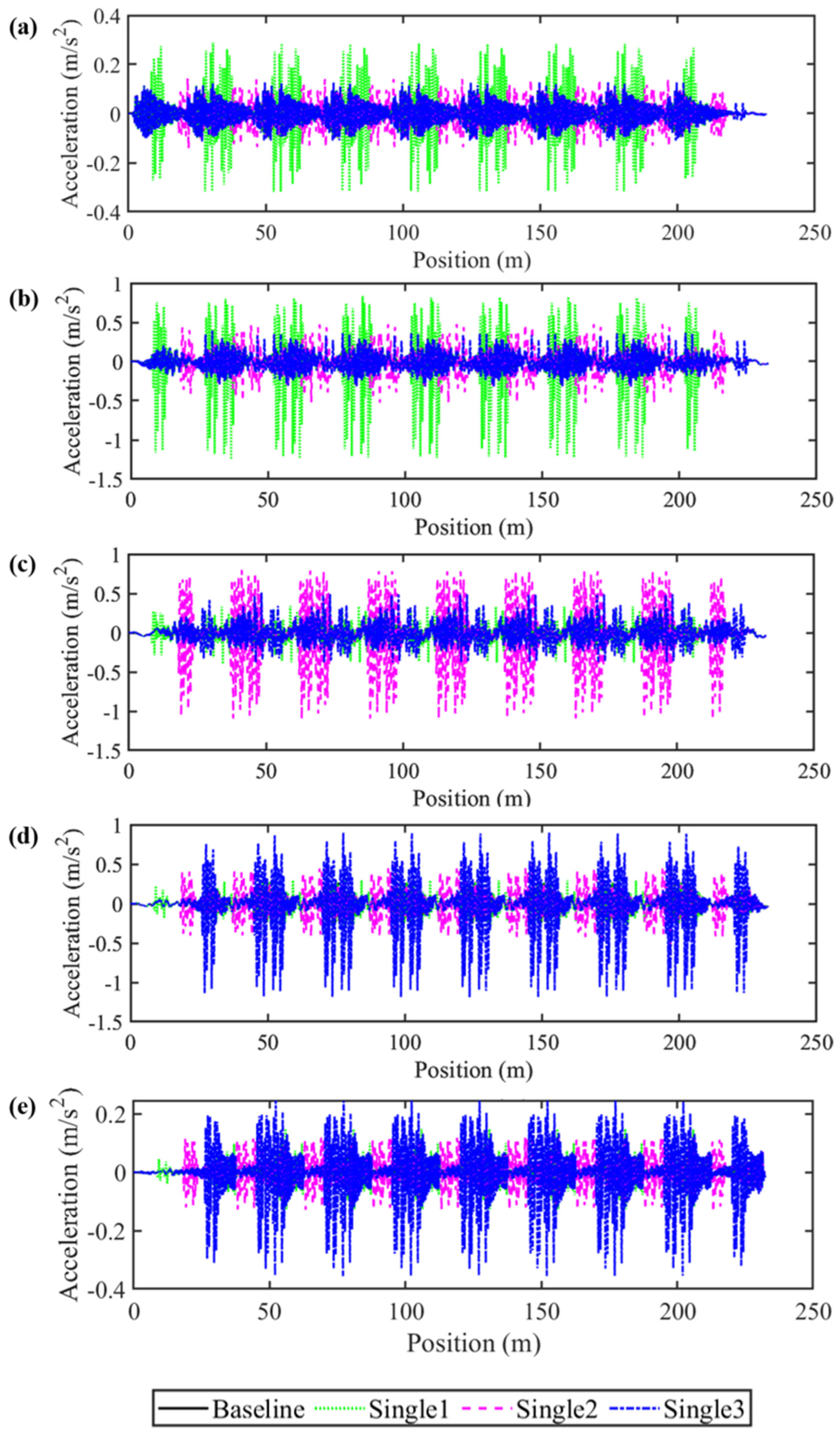


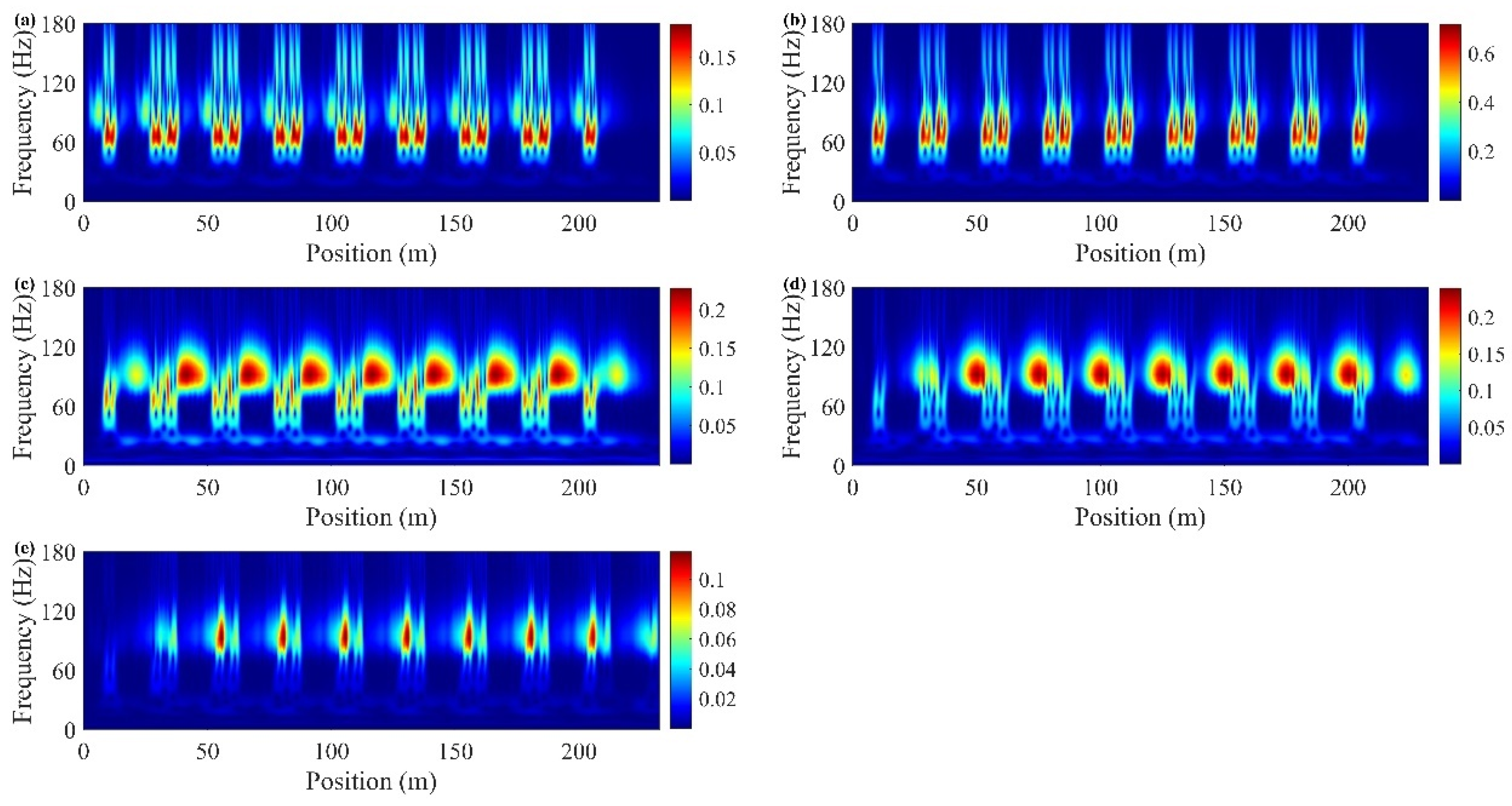
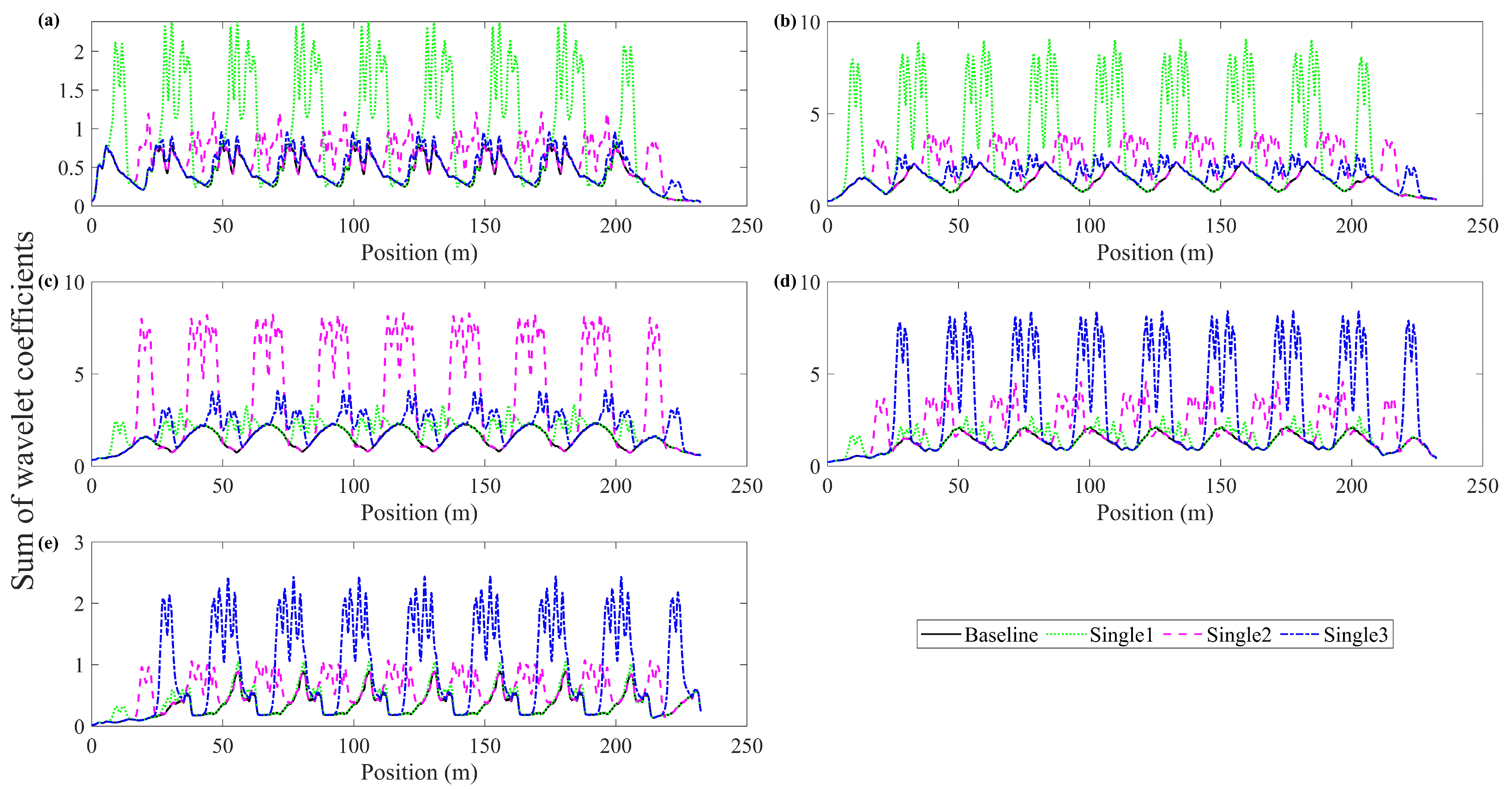
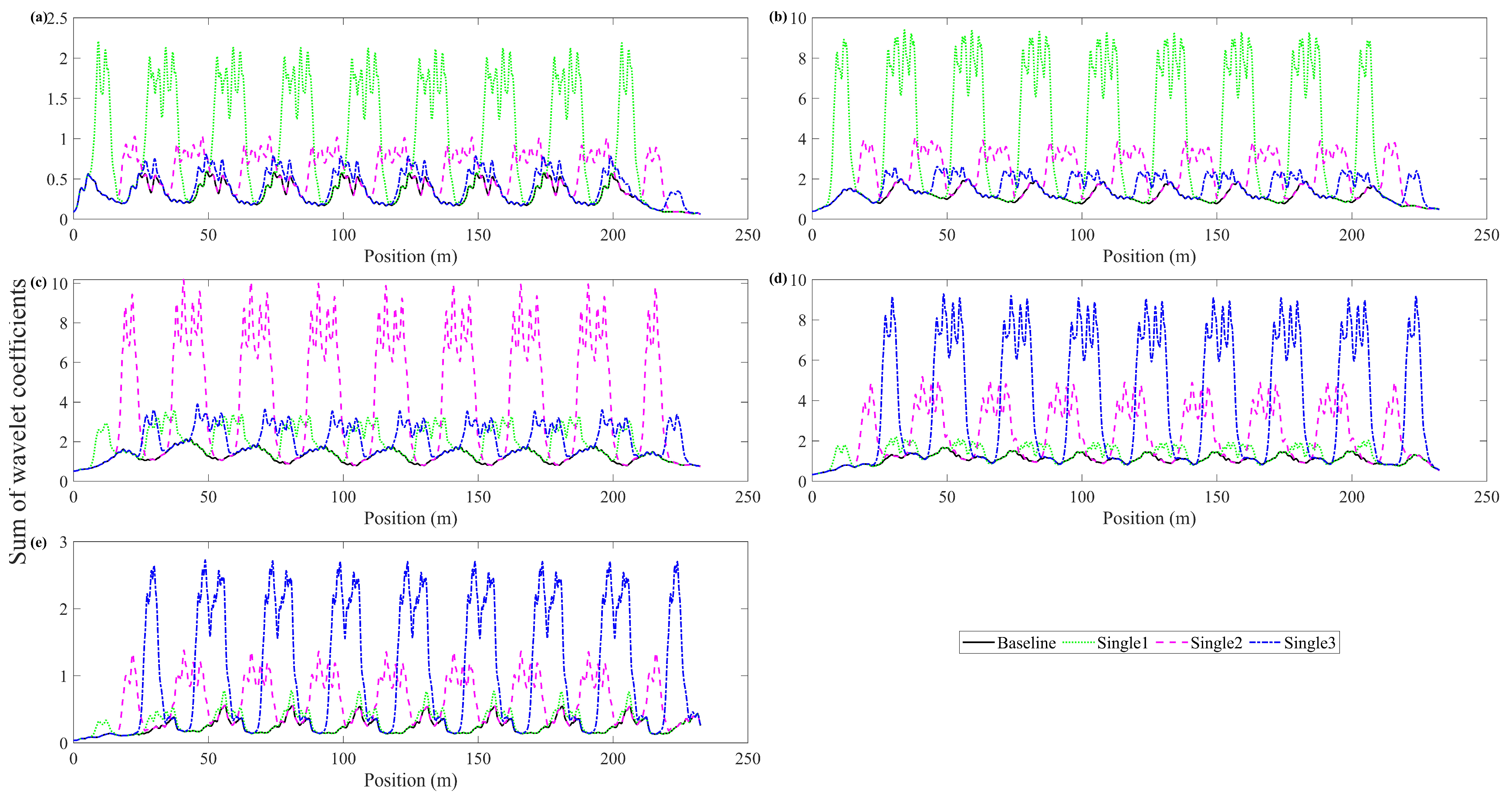
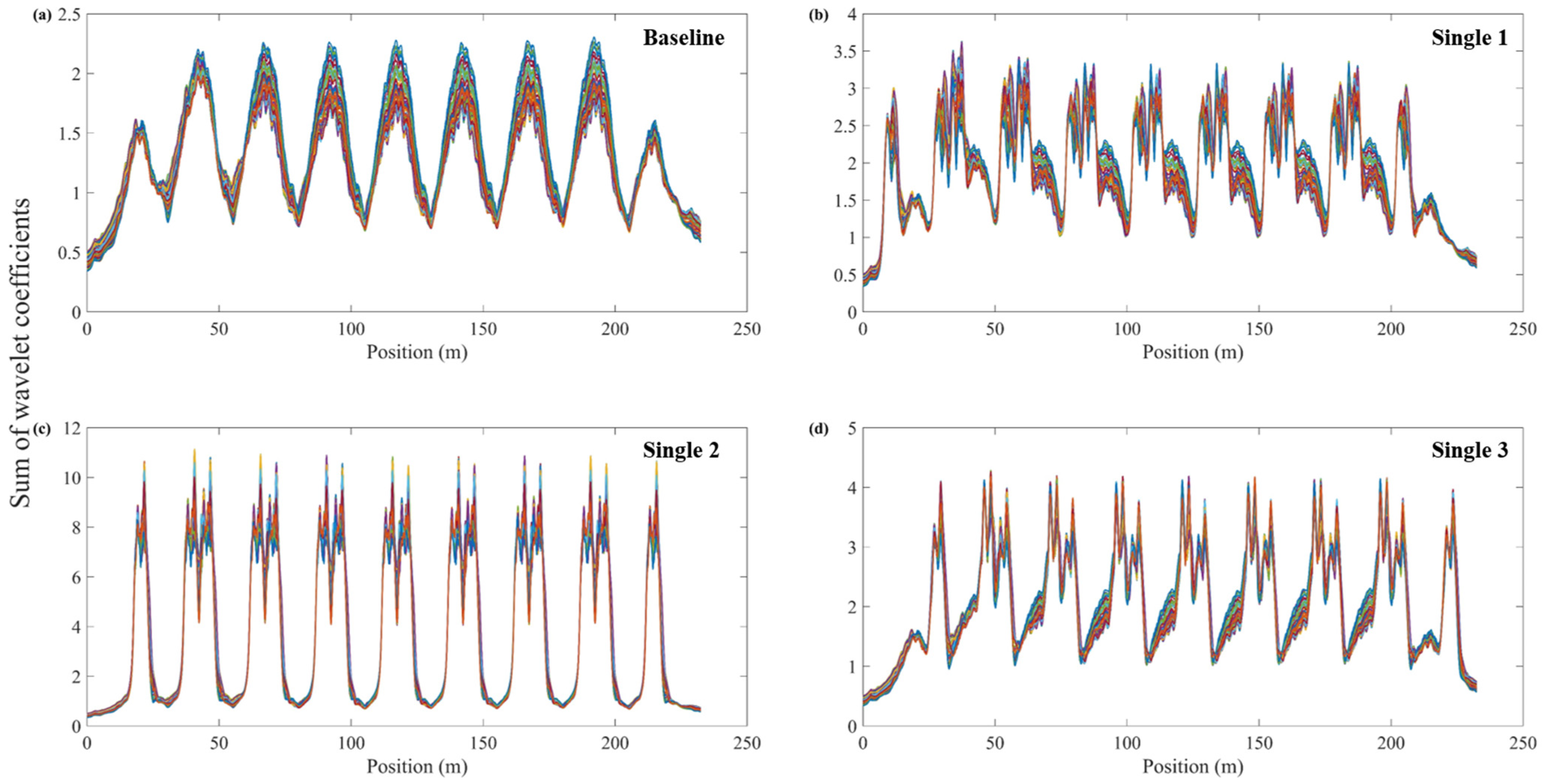
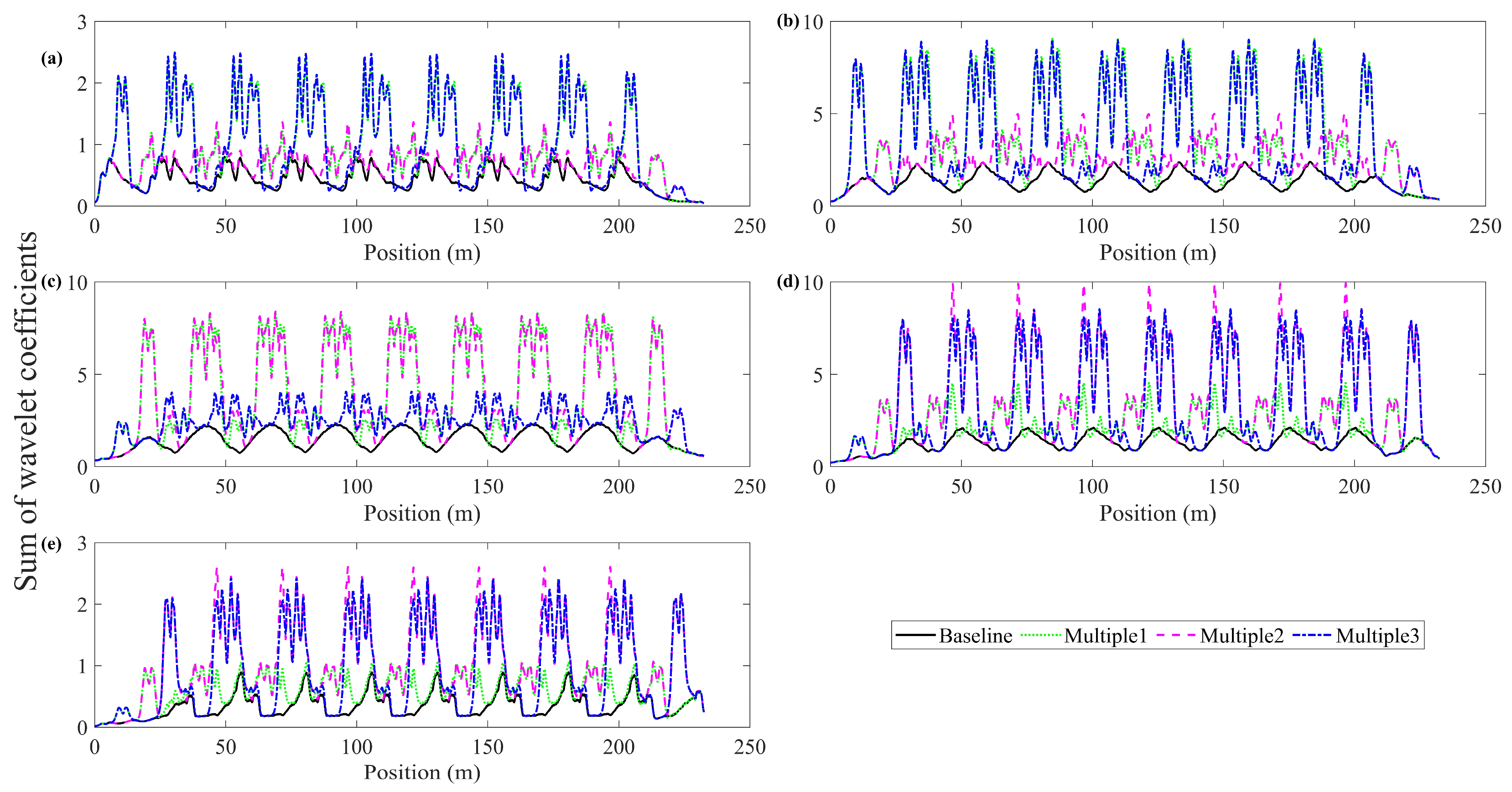
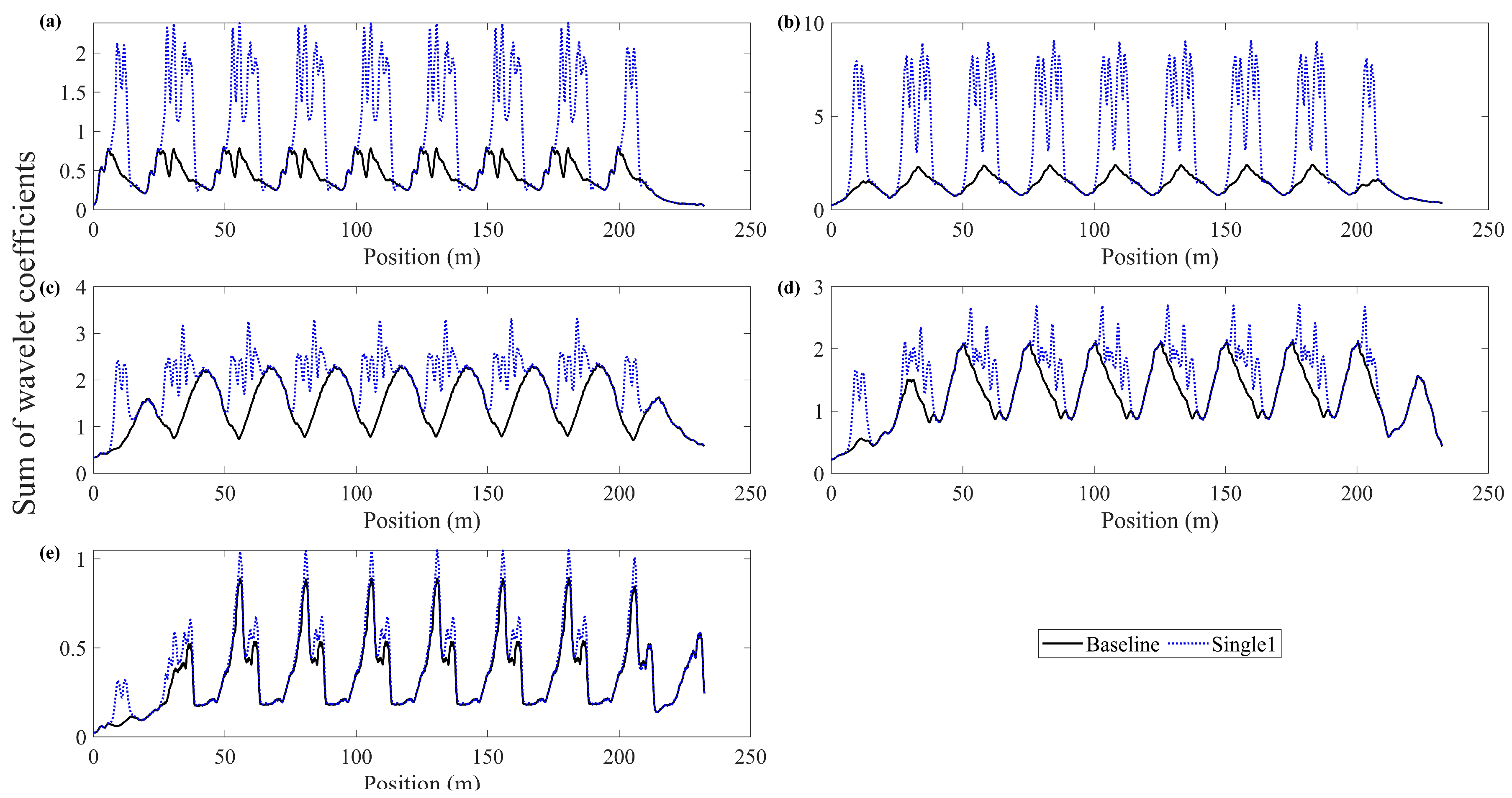



Disclaimer/Publisher’s Note: The statements, opinions and data contained in all publications are solely those of the individual author(s) and contributor(s) and not of MDPI and/or the editor(s). MDPI and/or the editor(s) disclaim responsibility for any injury to people or property resulting from any ideas, methods, instructions or products referred to in the content. |
© 2023 by the authors. Licensee MDPI, Basel, Switzerland. This article is an open access article distributed under the terms and conditions of the Creative Commons Attribution (CC BY) license (https://creativecommons.org/licenses/by/4.0/).
Share and Cite
Mo, Y.; Zhuo, Y.; Li, S. Local Track Irregularity Identification Based on Multi-Sensor Time–Frequency Features of High-Speed Railway Bridge Accelerations. Sustainability 2023, 15, 8237. https://doi.org/10.3390/su15108237
Mo Y, Zhuo Y, Li S. Local Track Irregularity Identification Based on Multi-Sensor Time–Frequency Features of High-Speed Railway Bridge Accelerations. Sustainability. 2023; 15(10):8237. https://doi.org/10.3390/su15108237
Chicago/Turabian StyleMo, Ye, Yi Zhuo, and Shunlong Li. 2023. "Local Track Irregularity Identification Based on Multi-Sensor Time–Frequency Features of High-Speed Railway Bridge Accelerations" Sustainability 15, no. 10: 8237. https://doi.org/10.3390/su15108237
APA StyleMo, Y., Zhuo, Y., & Li, S. (2023). Local Track Irregularity Identification Based on Multi-Sensor Time–Frequency Features of High-Speed Railway Bridge Accelerations. Sustainability, 15(10), 8237. https://doi.org/10.3390/su15108237





